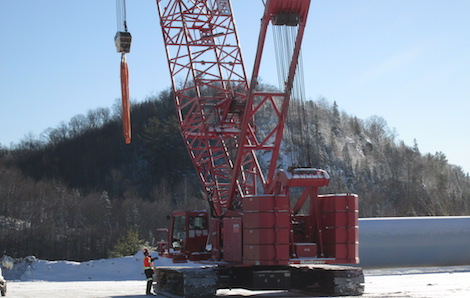
The Goulais Wind Farm along the pre-Cambrian shield north of Sault Ste. Marie will generate enough electricity to serve the needs of 12,000 households.
The towers will each be 33 storeys (330 feet) high.
Three blades will swing high in an arc peaking 18 storeys above the hub.
One turbine will generate 2.3 megawatts.
Collectively, the 11 towers are capable of 25 MegaWatts.
Best of all, the decibel levels emitted will be about 25 percent less than the existing Prince 1 and 2 arrays, say the people behind the project.
According to Dave Eva, vice president of Capstone Infrastructure Corporation, owners of 51 percent of the project, the decibel levels will be barely a whispered conversation on the other side of a large room.
The nearest tower, 1.6 kilometres from Beaumont Park with terrain between the tower array site and the residences, will prevent any sound penetration.
The array itself will only be visible from the highway as it crosses the Goulais River six kilometres away.
Naithen M. Joseph of Goulais River is the site manager for Capstone.
His father, Naithen Joseph Sr., is leading the site preparations for the connecting roads, and levelling the terrain's dips and crowns.
The tower's blades will be transported on 200-metre-long tag trailers.
A steering mechanism on the tail end will allow better handling around curves.
Carlsun Energy Solutions Inc., a firm based in Port Elgin, is in the midst of marshalling tower components at the secured yards at Heyden.
The actual generators will be Siemens Canada Ltd. of Stoney Creek, Ontario.
The two large cranes, now visible to passers-by on the highway, look large but the crane required to hoist the three-bladed configuration will be five times larger.
It will arrive on 25 to 30 transport trailers, and will be erected near the base of the first tower beginning the second week of January.
Joseph, the site manger, described the process.
"Once the tower has been erected, and the three blades secured to the hub, the huge crane will hoist the assembly up 99 metres (325 feet) to the swivelling tower cap. Once the hub shaft is inserted and secured to the rotating cap, it will connect directly to the generator," he said.
Wind velocities as scant as two metres per second will begin to turn the mammoth airfoils.
If winds reach 25 metres per second (90 kilometres per hour), the blades will "feather" to shut down.
Unlike the existing arrays in the Prince Township Wind Farm owned by Brookfield Power, where wind speeds of 12 kilometres per hour are needed to begin rotation, the Goulais turbines will move with seven kilometres.
Each tower dome can rotate two and a half times in the same direction, seeking ideal gusts, and will rotate on a return axis again moving 2.5 times around in the opposite direction.
Naithen explained: "The interior of a tower will have a ladder, whereby a technician will be able to attach a safety harness, and another clip, to a spring band, to help ascending inside, to the top of a tower."
The "band" he likens to a rubber band, which under tension lifts approximately 25 percent of his body weight.
The technology introduced to this project by Siemans Canada employs a "gearless" generator connected to the blades' hub shaft and the AC generator.
All 11 tower generators will tie in to a main substation to convert to DC current, and finally returning it to alternating current before being streamed into the Great Lakes Power grid lines running 200 metres away.
Capstone's Dave Eva said environmental studies on this site began in 2008, with traditional consultations with First Nations in the region leading to a partnership.
Quoting from a Capstone news release issued in Toronto on September 30: "Following construction completion, the financing will convert to a fully amortizing term loan maturing in 2035."
Capstone and the Batchewana First Nations have contributed a combined $23.5 million in equity for the project, for a total of $100 million.
The Goulais Wind Farm is expected to be commissioned during the second quarter of 2015.
Mr. Eva added: "Wind energy generation does not pollute the environment, nor contribute to climate change, unlike coal or biomass or nuclear fuelled power plants. Wind power's price is fixed and known for years in advance, whereas other forms fluctuate, mainly upward as raw resources supplies and demand dictate. Solar energy is more expensive than wind generated power. We are coming very close to cost parity now, with conventional forms of energy."
Other Sault-based companies involved in the Goulais development include: Hensen and Tregonning Logging Limited; Meakin Forest Enterprises Inc.; Tulloch Engineering; and Batchewana Band Industries, Blue Heron Industrial Park, Rankin.